Main information:
Schleißheim Old Palace
Museum / collections
The Museum at Schleißheim Old Palace, a branch of the Bavarian National Museum houses two collections: "The religious year and its festivals" (Gertrud Weinhold Collection) and the East and West Prussia Collection "There once was a land …"
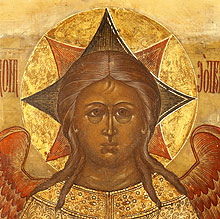
Icon of Christ the Holy Silence.
Wood, levkas, egg tempera.
Russia, ca. 1700
"The religious year and its festivals"
(Gertrud Weinhold Collection)
The permanent exhibition has over 6,000 items in 250 cases illustrating religious culture round the world. They were collected and arranged by the Berlin patron and honorary professor Gertrud Weinhold (1899-1992), and willed to the Free State of Bavaria.
The wide spectrum of works by pious laymen, assembled on the collector's numerous journeys, documents colourful seasonal customs with a variety of religious origins from all over the world. The exhibition provides a comparison of the religious festivals that have developed on the basis of holy writing.
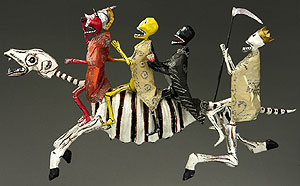
Riders of the Apocalypse.
Papier-mâché figures
by
Victor
Fosado
for the
Mexican
Day
of the Dead
or
All Souls
Day.
Mexico, 1965
This comparative approach was very advanced for its time and today has great potential for teaching both children and adults about the material culture of the world religions, and about our own customs and those of other faith. As well as illustrating traditional religious cultures, the museum also helps to promote a better understanding of the variety of confessions in modern society.
The collection is primarily devoted to the Christian confessions and includes a collection of over 120 nativity scenes, produced in all parts of Christendom and thus displaying a correspondingly wide range of techniques and materials.
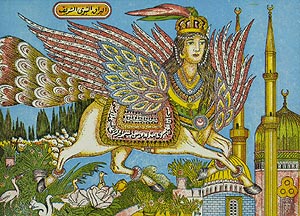
Buraq. Heavenly animal transporting
the Prophet
Mohammed.
Chromolithograph. Egypt, ca. 1960
An equal amount of space is devoted to the passion of Christ and above all the Easter Mystery, analogous to the death cults of other peoples, as well as Easter customs (palm leaves, eggs etc.)
The "Overseas" section has a display of craftwork with religious themes from the missionary countries of Africa, the New World and Asia.
The exhibition closes with a section entitled "Paradise", which incorporates objects from the neighbouring religions of Judaism, Islam and Buddhism and illustrates the universal human vision of an after-life, the idea of an the eternal state of bliss which is common to all religions.
"There once was a land …" – East and West Prussia Collection
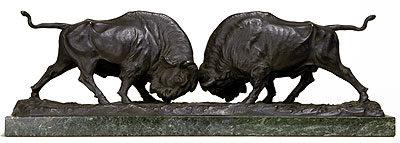
Fighting bisons. Bronze sculpture. Copy of a
sculpture by August Gaul of 1912 in front of the
district court in Königsberg,
popularly
known as
the "Public
prosecutor and defence
lawyer".
Ca. 1935
"There once was a land …" is the opening of a poem by Agnes Miegel, in which she mourns her lost East Prussian homeland. This is also the title of the permanent exhibition comprising around 400 exhibits which documents the history and culture of East and West Prusssia; for millions of people this easternmost Prussian province is only a memory following the expulsion of almost all the German population in 1945.
The development of an old, formerly German rural society, is traced In words and pictures, beginning with the missionary activities of the Teutonic Knights, who colonized the region. Later epochs are illustrated with a copperplate engraving showing the anointing of the first Prussian king Friedrich I in 1701, orders and a comprehensive collection of coins.
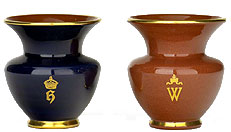
2 small vases. Cadine majolica
with
the crowned
gold initials
of
Emperor "W(ilhelm II)" and his
second wife "H(ermine)".
Ca. 1920
Other rooms show what life was like in the towns and countryside. The East Prussian heraldic animal is represented by a massive elk head. Another natural "symbol" of the area is amber, with the largest deposits in the world located on the Samland coast and known as the "gold of the Baltic"; the collection includes many fine objects made of this stone. The work of the "Royal majolica and terracotta workshop" of Wilhelm II, which was founded in 1904 in Cadinen, is equally famous.
The museum also has a section devoted to "Famous personalities", in particular Immanuel Kant. The writers Ernst Wichert, Max Halbe and Agnes Miegel and the painter Lovis Corinth are represented with signatures, pictures or a death mask. A further section deals with "The University of Königsberg (Albertina)": founded in 1544 it also attracted students from other countries and became the mainspring of important intellectual movements. And the "Religious tolerance" section describes how the country between the Rivers Weichsel and Memel accommodated many different groups of people. The exhibition closes with information about the work of the East and West Prussia Foundation in Bavaria, which supplied the exhibits.
© Text and pictures: Bayerisches Nationalmuseum

Facebook Instagram YouTube